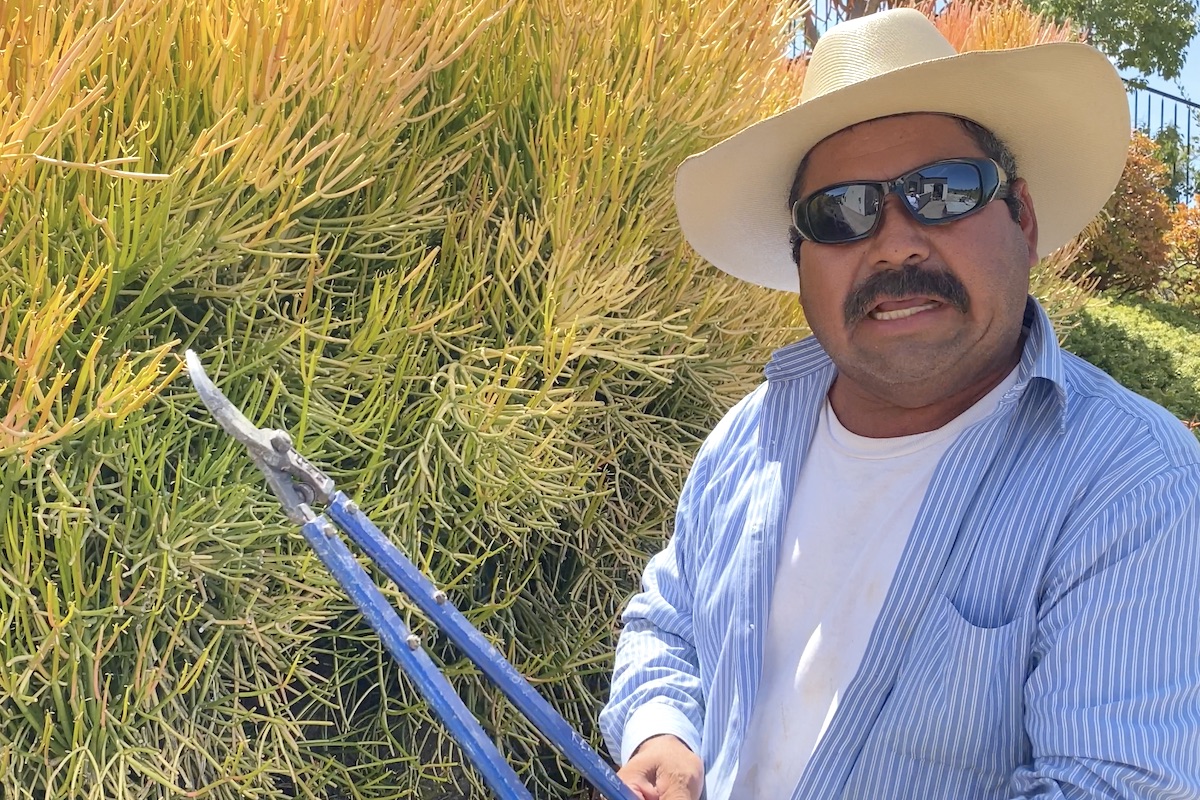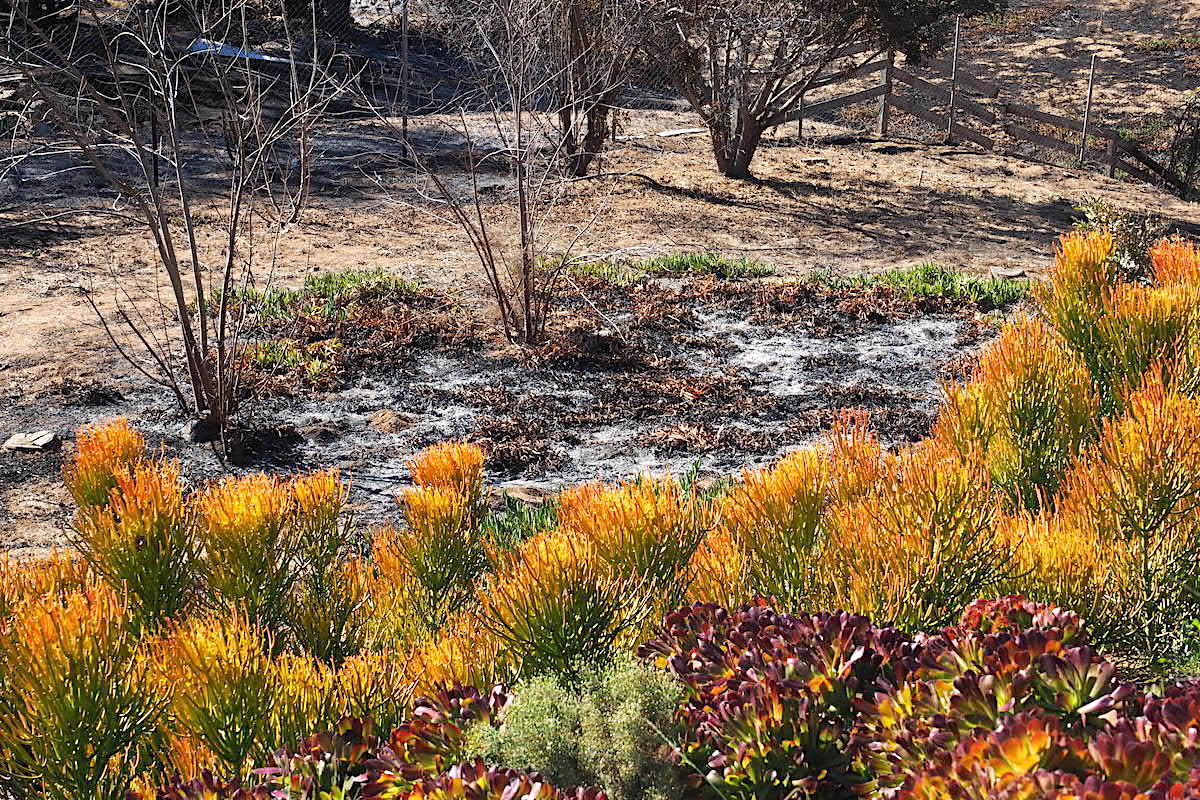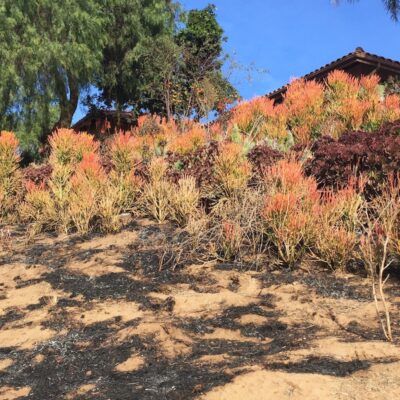
How to Prune and Handle Euphorbia tirucalli ‘Sticks on Fire’
In my new English-Spanish video, landscaper José Arias of Borrego Springs, CA explains and shows how to manage a beautiful succulent with toxic, milky sap: Euphorbia tirucalli ‘Sticks on Fire’.
En inglés y español, el paisajista José Arias de Borrego Springs, CA explica y muestra cómo podar y manipular árbol de los dedos, una hermosa suculenta que tiene una savia lechosa y tóxica.
About Euphorbia tirucalli 'Sticks on Fire'
This South African succulent, sometimes called firesticks or pencil tree, originated as a sport (offshoot) of larger, solid-green Euphorbia tirucalli. Both are easy to grow in coastal areas of Southern California and Mexico where temperatures stay above 32 degrees. Over time plants get large---up to 15 feet tall.
Be careful pruning it
Like all euphorbias, 'Sticks on Fire' has a white, milky sap. The liquid can cause irritation of the skin and is especially painful and dangerous to the eyes. In the video, Sr. Arias tells how not knowing this sent him to the hospital. Obviously, you shouldn't plant it or any other euphorbia where children and pets play.
Clean your hands and tools
USE MECHANICS' HAND CLEANER. In the video, Sr. Arias advises washing with soap and water. Even better, according to a nursery owner friend, is the hand cleaner mechanics use. Euphorbia sap isn't water soluble, so you risk spreading it if you dilute it. But mechanics' hand cream contains a solvent that breaks down the sap. You can even apply it to globs that stick to clothes, before you launder them. One brand is GoJo (affiliate link).
How much should you cut?
It handles any amount of pruning. I've grown several in planter boxes for years. The same specimens in the ground would likely be huge by now, but I keep mine pruned to under 2 feet. You can see them in the background of my Top 7 No-Fail Succulents video:

What do do with cuttings
Carry them to the green waste bin by the dry branches, with raw ends facing away from you. Or use them to start new plants: Simply stick upright in coarse, friable soil that drains well.
Prune in summer or fall
Best time to trim euphorbias is during the dry season. After winter and spring rains, the plants may become engorged with sap that may squirt when limbs are cut.
Plan for drips
In my video, cuttings land on a dirt bank, so dripping sap doesn't matter. When I prune mine, I set cuttings on newspaper to catch milky puddles. Then I wrap the newspaper around the cuttings when I transport them. The latex sap doesn't damage hardscape, but it's sticky, and I don't want to track it into my house.
Essential items
Note that when pruning Euphorbia tirucalli, Sr. Arias wears gloves, long sleeves and trousers (so sap doesn't get on his skin), plus sunglasses. Instead of short pruners, he uses long-handled "bypass loppers."

Long-handled pruners (bypass loppers) let you trim euphorbia branches with precision while staying well away from dripping cuts. They're useful for many other pruning tasks as well.
Why grow 'Sticks on Fire'?
It's colorful and practical. As far as I'm concerned, it's main downside is that it's frost-tender. Apart from occasional trimming (every three or four years), it needs no care at all.

Its liquid sap makes 'Sticks on Fire' an effective firebreak (shown here in Dr. Camille Newton's garden).

It repeats the red of aloes in midwinter
'Sticks on Fire' needs no more water nor care than large agaves, and contrasts beautifully with them in color and texture. It makes a statement in any landscape, especially amid large boulders.
Bottom Line: Follow José's simple tips on how to trim and manage Euphorbia tirucalli (arbol de los dedos), and it will be an enhancement to your landscape for years to come.
Related Info on this Site
Succulent Euphorbias: Photos, IDs, Garden Uses, Cautions
Euphorbia Uses, Photos and Cautions Native primarily to South Africa, succulent euphorbias are sculptural and collectible, but do be careful when handling them See All Succulent Types Aeonium Agaves Aloes Cactus Crassula Echeveria Euphorbias Ice Plants Kalanchoe Portulacaria Senecio About SUCCULENT EUPHORBIAS Euphorbia is a huge genus composed of plants with milky sap, including spurges and…
Did Succulents Protect These Homes from Wildfires?
Southern CA homeowners in Rancho Santa Fe and Bonsall say succulents protected their homes during two different wildfires. In each case, nearby homes burned to the ground.



Succulent expert Duke Benadom writes: “You may wish to use to word ‘caustic’ along with ‘toxic’ meaning the plant is harmful from its exudates, along with its poisonous properties.” (An exudate is that which is exuded; i.e. a secretion. “Caustic” means “able to burn or corrode organic tissue by chemical action.”)
Pruning a large Fire Stick plant . Been cutting branches off , 2′ long , has a big main branch . I have been planting the whole branch . Is that too big ? Mesa , Arizona.
Are you asking if it’s OK to plant the trunk after you’ve pruned off the small branches? I’ll bet you could, but I’ve never actually tried it.
I loved Jose’; what a sweet guy! Thanks for the info. While watching the video I started getting an itch on my face!
Ha! I know, right? Like talking about mosquito bites.
How should I deal with frostbitten sticks.. Can I trim them back or should I just replace?
Hi Gloria, Yes, trim them back once all danger of frost is passed.
Hi! I am in south Louisiana. Not the best location for succulents and cacti.
I love your book ’Designing with Succulents’ and browse often. I use what I can and dream the rest.
Having anyone to discuss these plants is obscure. However it does not discourage me even though I know this is not the ideal location for cultivating cacti and succulents.
I do not want to be challenged. There was a time but time is at a premium and I want to do this for pure enjoyment.
Your book allows me to do so in a way. Thank you.
Maggie
What a lovely comment, Maggie! Thank you! I’m going to pass this along to my publisher, Timber Press. They’ll be pleased to know the book has potential for a broader audience than gardeners in milder, less humid parts of the country (and world).
Hi Debra, Tnx for all that u do, I’m really loving succulents bec of people like u who love to educate people like me 😁, what do u call the balls at the end of my tirucalli? Are they seed pods? These balls look like flower buds but they don’t bloom
Hi Lea — They’re seed capsules that follow tiny flowers. See photos on this site’s Euphorbia page.
Hi – thanks for the information on fire sticks living in Lake Havasu AZ my neighbor will give me some prunes from her bushes –do i just plant the cut offs in the ground ? how deep ? do they require some water to get them growing? I removes 2 Sissoo trees and have holes to plant them in— also water lines are still in place– Hopefully you have some answers –THANKS
Hi Steve — Plant them as you would any succulent cuttings: So they stand upright. This time of year fire sticks are dormant, so rainfall is all they need. They’re frost-tender, but I checked winter lows for Lake Havasu, and it doesn’t look look like that’s a problem.
I need to know how to clean the sap off the pruners and hand saw I used to try to rid my daughters yard of these monster trees. Too many young children and planted in very bad areas. I’m really struggling. We were very careful with the first one and did pretty well but the huge trunk is still needing to be dealt with. Should I try a saws all electric tool???
Hi Donna — Oil your saw or pruners so the sap doesn’t stick (vegetable oil will do). Wipe off the sap w disposable towels from time to time and reapply oil. Don’t let the sap dry on tools. When you’ve finished the job, clean with warm water and dish soap (use a scrub brush) or better yet, with the hand cleaner I mention in the article: GoJo.
Hello, thank you for all your information. I have a fire stick that is grown very tall and I want to shorten it. Do I just saw off at the height that I want? I also need it to be thinned out. Is there a process to that? I also replanted cuttings, and they don’t seem to be growing. Do I need to clip the tip of the branches?
Yes, the plants can be pruned as shown in the video, to any height or density you want. Cuttings will root from the cut end—stand them up in good soil. Those about a foot high have the best chance of taking hold. Much smaller and you’ll wait forever for them to get big; much larger, there’s too much top growth for new little roots to sustain. It goes without saying, take proper precautions to protect your skin and especially your eyes from the milky sap. After rains and during spring growth, hydraulic pressure inside the plant is high and it may be so turgid with sap it’ll squirt when cut.
I recently ripped out lots of self seeded euphorbias in a garden and as there is a lot of material would it be safe to burn the plants after they dry out a little.
For the last two years, I’ve have a couple of these planted in my yard in Phoenix, and I’m struggling to understand how to care for them. They seem to grow large (but not too tall) and very dense over the summer and fall forward from the weight. A section of each plant, near the back, also seems to die off, which I eventually remove. They get direct sun most of the day, and they’re planted next a block wall. The plants are on a drip system, but maybe I’m giving them too much water? It seems like they need to be thinned out, but I’m unsure if this will make them stand up again.. Any ideas?
Hm. Not at all familiar with growing them in Phoenix. I’d think most euphorbias wouldn’t do well there—too far from the maritime climate they prefer. Too hot and too cold. But you know who would know is Noelle Johnson, “The Arizona Plant Lady.” If it’s not too much bother, I’d love to know what she advises. (Tell her Debra sent you.) Thanks!
Is there an antidote for the sap should it get on your skin?
Hi Dan, The short answer is there’s no antidote. For the long answer, read what the National Institute for Health advises.
Hi Debra, thank you for this video. It was recommended to me by the arboretum when I asked them how to transplant euphorbia. I have a large euphorbia grandicornis (6 x 6) that needs some care. The prior owner let it go wild growing in all directions (even horizontally in the middle), and now it looks like two plants (bifurcated). It also needs major weeding but I can’t reach in to dig out the weeds. Do you think it has any value for keeping in the garden? How would you use it landscaping? One idea I had to salvage it was to split it in two to prune off the horizontal pieces, preserve it and encourage it to grow in an upright shape. I would need to uproot it to have a shot at weeding it. It is difficult to work with a plant you can’t touch. Do you have any suggestions for saving the plant? Is it possible to transplant such a mature plant? Or do you think this plant is too much of a hazard to keep? Thanks for any ideas.
Hi JP — It sounds like a lot of work for a plant that has seen better days. I’d look at it from an aesthetic standpoint: How important is this plant to the overall appearance of the garden? If “not much” then get rid of it. You can send me a photo if you like in a response to one of my newsletters.
If you want to salvage it, wear gloves and long sleeves and eye protection. If you don’t have a wheelbarrow, put a disposable drop cloth (or newspaper) where the cuttings are going to land. Use long-handled pruning shears. Cut at the joints and use the tips of the shears to drag the pieces out and onto the drop cloth.
I’d prune to a vase shape, so new growth goes outward and not inward. It could look cool as it grows back—like a living sculpture, a conversation piece in the garden.
Prune back until you can get at the weeds. Let any cut ends finishing oozing before you go after them. Using a long artist’s brush, paint green leaves with a systemic weed killer that will kill the roots. Wait a few days for them to die, soak the soil, and pull or scrape them out.
Treat the area now and in the fall with a pre-emergent herbicide that prevents seeds from germinating. Or if, like oxalis, they grow from corms, use a treatment specific to that type of weed.
(Edit)